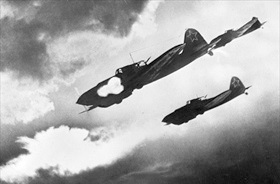GERMANS FACE CALAMITY AT KURSK
Kursk, Soviet Union · July 13, 1943
On this date in 1943 Operation Citadel (Zitadelle), Adolf Hitler’s gambit to retake Kursk, an important Soviet rail hub south of Moscow, and straighten the German line on the Eastern Front failed with devastating losses on both sides, but especially to German strategic armored reserves. A day earlier a gigantic clash of arms approaching mythic status—upwards of 6,000 tanks, 4,000 airplanes, and two million men—ended in a draw near the village of Prokhorovka. Nevertheless, the eleven-day Battle of Kursk was evidence that German fortunes were shifting toward the Soviet Union in that country’s Great Patriotic War. In the course of three major engagements between July 4 and August 23, 1943, the Wehrmacht suffered over 200,000 casualties and lost an estimated 760 tanks and assault guns and more than 680 aircraft. Soviet losses were many times higher for the same period; for example, over 863,000 casualties alone. But the Wehrmacht had grown powerless to stanch or keep pace with the steady influx of Red Army soldiers (some drafted from retaken territories) and new materiel arriving on the Eastern Front, much of the equipment provided by Allied Arctic convoys and overland shipments through Iran. Furthermore, Soviet dictator Joseph Stalin’s long-standing call for a second front materialized three days earlier, on July 10, 1943. The Anglo-American landings in Sicily (Operation Husky) engaged more troops than were involved in the Normandy landings eleven months later (Operation Overlord). The Sicily landings were followed by those on the Italian mainland in September. Taken together, events in the Mediterranean forced Hitler to redeploy forces from the Eastern to the Italian Front. From the conclusion of the Kursk clash of men and armor to the end of the war in Europe less than two years later, Stalin’s armies advanced relentlessly westward across a broad front. In a series of vicious hammer blows, the Soviets decimated Hitler’s Army Group Center in Belarus (Operation Bagration), annihilated Army Group South in the Ukraine, and inflicted crushing casualties while knocking Axis partners Romania and Hungary out of the war. (In early 1943, after Stalingrad, Hitler’s comrade-in-arms, Benito Mussolini, withdrew his armed forces from the East.) By February 1945 both Hitler’s Wehrmacht and his Thousand-Year Reich lay at death’s door.
[amazon_carousel widget_type=”ASINList” width=”600″ height=”200″ title=”Recommended Reading” market_place=”US” shuffle_products=”False” show_border=”False” asin=”0811735028,141657350X,0752457160,1844159779,1906033099,1906033013,0811733718,0974838942,1848843933,1906033897″ /]
The Wehrmacht Retreats: Fighting a Lost War, 1943–1945
 |
Above: Soviet advances on the Eastern Front, August 1943 to December 1944.
 |  |
Left: Soviet armor advances to engage the enemy during the Battle of Kursk. The combined Voronezh and Steppe Soviet fronts deployed about 2,418 tanks and 1,144,000 men.
![]()
Right: A Waffen-SS Tiger I tank scores a direct hit on a Soviet T‑34 medium tank during the German offensive at Kursk, Russia, July 5–16, 1943. The quality of the optics of the Tiger I and the high velocity 88mm gun it mounted allowed it to devastate targets at long range with great accuracy.
 |  |
Left: Soviet IL-2 combat aircraft attack an enemy formation in the southern sector of the Kursk salient, July 1943. The Soviet offensive lasted from July 12 to August 23, 1943.
![]()
Right: Soviet antitank riflemen take aim at an enemy tank after the Battle of Kursk had wound down, July 20, 1943. The 11-day German offensive at Kursk was the first time a Blitzkrieg had been defeated before it could break through enemy defenses and into its strategic depths. Kursk was the Soviets’ critical contribution to winning the war against Hitler and his Third Reich.
Soviet Color Footage of the Battle of Kursk, Russia, July 1943
![]()

 History buffs, there is good news! The Daily Chronicles of World War II is now available as an ebook for $4.99 on Amazon.com. Containing a year’s worth of dated entries from this website, the ebook brings the story of this tumultuous era to life in a compelling, authoritative, and succinct manner. Featuring inventive navigation aids, the ebook enables readers to instantly move forward or backward by month and date to different dated entries. Simple and elegant! Click
History buffs, there is good news! The Daily Chronicles of World War II is now available as an ebook for $4.99 on Amazon.com. Containing a year’s worth of dated entries from this website, the ebook brings the story of this tumultuous era to life in a compelling, authoritative, and succinct manner. Featuring inventive navigation aids, the ebook enables readers to instantly move forward or backward by month and date to different dated entries. Simple and elegant! Click 











